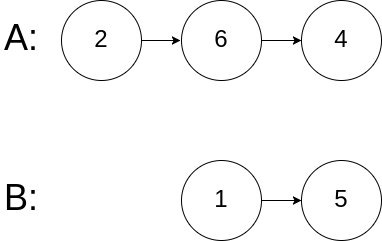找出两个链表的交点
题目:
Write a program to find the node at which the intersection of two singly linked lists begins.
For example, the following two linked lists:
begin to intersect at node c1.
Example 1:
Input: intersectVal = 8, listA = [4,1,8,4,5], listB = [5,0,1,8,4,5], skipA = 2, skipB = 3
Output: Reference of the node with value = 8
Input Explanation: The intersected node's value is 8 (note that this must not be 0 if the two lists intersect). From the head of A, it reads as [4,1,8,4,5]. From the head of B, it reads as [5,0,1,8,4,5]. There are 2 nodes before the intersected node in A; There are 3 nodes before the intersected node in B.
注意:交点指的是同一个对象(PointA == PointB)!不是两个Node值相同 (PointA.val == PointB.val)
Example 2:
Input: intersectVal = 2, listA = [0,9,1,2,4], listB = [3,2,4], skipA = 3, skipB = 1
Output: Reference of the node with value = 2
Input Explanation: The intersected node's value is 2 (note that this must not be 0 if the two lists intersect). From the head of A, it reads as [0,9,1,2,4]. From the head of B, it reads as [3,2,4]. There are 3 nodes before the intersected node in A; There are 1 node before the intersected node in B.
Example 3:
Input: intersectVal = 0, listA = [2,6,4], listB = [1,5], skipA = 3, skipB = 2
Output: null
Input Explanation: From the head of A, it reads as [2,6,4]. From the head of B, it reads as [1,5]. Since the two lists do not intersect, intersectVal must be 0, while skipA and skipB can be arbitrary values.
Explanation: The two lists do not intersect, so return null.
Notes:
- If the two linked lists have no intersection at all, return
null. - The linked lists must retain their original structure after the function returns.
- You may assume there are no cycles anywhere in the entire linked structure.
- Your code should preferably run in O(n) time and use only O(1) memory.
法一:
如果两个链长度相同,那么同时向后移动指针,对应的一个个比下去就能找到,所以只需要把较长的链表变短即可,使得两个链表长度相同:
定义两个指针,分别指向A,B链表头;
分别遍历链表A, B, 得到A,B的长度,计算长度差值diff;
把两个指针移回链表头部,把较长的链表的指针,先从头向后移动diff;
两个指针,一一比较,每次同时向后移动一步。
/**
* Definition for singly-linked list.
* public class ListNode {
* int val;
* ListNode next;
* ListNode(int x) {
* val = x;
* next = null;
* }
* }
*/
public class Solution {
public ListNode getIntersectionNode(ListNode headA, ListNode headB) {
int alength = 0;
int blength = 0;
// 链表A B长度
ListNode aNode = headA;
ListNode bNode = headB;
while(aNode != null) {
alength++;
aNode = aNode.next;
}
while(bNode != null) {
blength++;
bNode = bNode.next;
}
// 将指针移回头结点
aNode = headA;
bNode = headB;
// 移动较长链表的指针diff步
int diff = alength - blength;
if(diff >= 0) {
while(diff != 0) {
diff--;
aNode = aNode.next;
}
} else {
diff = -1 * diff;
while(diff != 0) {
diff--;
bNode = bNode.next;
}
}
// find intersection
while(aNode != bNode) {
aNode = aNode.next;
bNode = bNode.next;
}
return aNode;
}
}
法二:
用环的思想来做,我们让两条链表分别从各自的开头开始往后遍历,当其中一条遍历到末尾时,我们跳到另一个条链表的开头继续遍历。两个指针最终会相等,而且只有两种情况,一种情况是在交点处相遇,另一种情况是在各自的末尾的空节点处相等。为什么一定会相等呢,因为两个指针走过的路程相同,是两个链表的长度之和,所以一定会相等。
代码很简洁
/**
* Definition for singly-linked list.
* public class ListNode {
* int val;
* ListNode next;
* ListNode(int x) {
* val = x;
* next = null;
* }
* }
*/
public class Solution {
public ListNode getIntersectionNode(ListNode headA, ListNode headB) {
ListNode aPointer = headA;
ListNode bPointer = headB;
// Intersection 条件: aPointer == bPointer, same address! Not aPointer.val == bPointer.val (see example 1)
while(aPointer != bPointer) {
aPointer = (aPointer != null) ? aPointer.next : headB;
bPointer = (bPointer != null) ? bPointer.next : headA;
}
return aPointer;
}
}



